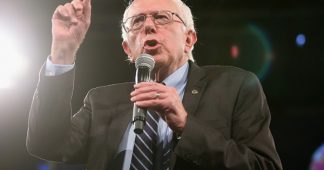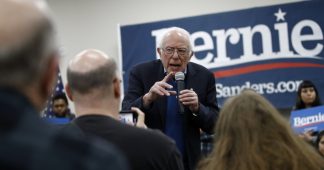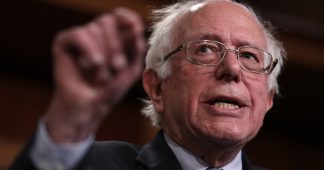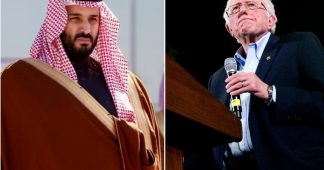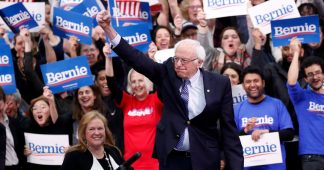The similarities between 2020 and 1972 are too astonishing to ignore. But there’s one big difference.
By Derek Thompson
Let me begin with a confession. When I started to report out and write this article, I had a simple thesis: Bernie Sanders is not George McGovern.
The catastrophic loser of the 1972 presidential election, McGovern has become a convenient bogeyman for any moderate or conservative arguing that leftism is a fatal disease in a general election. McGovern won just one state, Massachusetts, while the incumbent, Richard Nixon, commanded 96 percent of the Electoral College vote. It was then the largest Republican landslide in U.S. history.
But the more I read about McGovern’s candidacy, the more I realized that the spirit of ’72 is alive today—just not necessarily in the way that most Sanders critics think.
To start, let’s play a game of “Name That Year.” Here are four clues.
- A profoundly unethical Republican sits in the White House during a fairly strong economy.
- In the Democratic primary, the early front-runner and establishment favorite is a veteran East Coast senator.
- But after months of leading in the polls, he falters in the early primaries, soon after the GOP president and his cronies concoct a scheme to undermine him —part of a dirty-tricks campaign that ultimately figures in an impeachment inquiry.
- Rising at the perfect moment to steal his momentum is a left-wing senator from a small, lily-white state. This senator advocates for single-payer health care and calls for the redistribution of wealth to the middle and lower classes. Over time, he consolidates the left-wing vote and bypasses an apoplectic Democratic elite with a grassroots campaign that—somewhat ironically, given his age— depends on the enthusiasm of young voters.
Every word of this description applies just as equally to 1972. Nixon was the incumbent. For much of the Democratic primary, his most likely challenger seemed to be Edmund Muskie, the long-serving senator from Maine, who had been nominated for vice president four years earlier. In February 1972, operatives for the Nixon campaign placed a forged letter in the Manchester Union-Leader newspaper, claiming that Muskie was prejudiced against French Americans. (The forgery is now known as the “Canuck letter.”) Muskie’s downfall provided an opening for McGovern. The left-wing senator drew enthusiastic support from newly enfranchised teenagers and won the Democratic nomination—before getting trounced by Nixon in November.
The similarities between McGovern and Sanders go far beyond the plot points that connect the stories of their ascendance. In matters of policy, rhetoric, and demographics, there is little doubt that McGovernism animates the Sanders campaign.
Many of Sanders’s policy priorities were central to McGovern’s platform 48 years ago, starting with health care. “McGovern called health care a human right and backed a free-at-the-point-of-service single-payer health-care plan,” says Joshua Mound, a historian at the University of Virginia who has written about the similarities between Sanders and McGovern. “He also proposed increased Social Security benefits, boosting union rights, steep hikes in taxes on the rich, and a universal basic income,” which he ultimately reworked into a jobs-guarantee proposal. Sanders’s policy platform includes all of those measures, right down to the federal jobs guarantee. It’s also worth pointing out that while McGovern’s pacifism (which was core to his rise to prominence on the left) finds its clear echo in Sanders, the Vietnam War made his foreign policy position more salient in 1972.
McGovern’s rhetoric—with its constant references to FDR’s legacy and the modern scourge of corporate greed—was effectively a first draft of Sanders’s standard riffs. Both men were explicit about their ambitions to extend the economic promises of the New Deal. Here is McGovern in 1972 (emphasis mine):
“Working men and women have been in the front lines of political progress, in all the great reforms sponsored by the Democratic Party since 1932, including civil-rights reforms in the middle 1960s. The party works for the people, and the people support their party. That has been the key to a better life for millions.”
And here is Sanders in 2019:
“Over 80 years ago, Franklin Delano Roosevelt helped create a government that made transformative progress in protecting the needs of working families. Today, in the second decade of the 21st century, we must take up the unfinished business of the New Deal and carry it to completion.”
These similarities extend to the way the two men juxtaposed corporate profiteering and the plight of the working class. Here’s McGovern in the same 1972 speech:
“Mr. Nixon cannot help working people even if he wants to, for his basic constituency is corporate power and corporate interests …
The Democratic Party gains its chief numerical strength from working people.”
And Sanders in 2019:
“Decades of policies have encouraged and subsidized unbridled corporate greed …
In opposition to oligarchy, there is a movement of working people and young people who, in ever increasing numbers, are fighting for justice.”
Finally, McGovern’s rise within the Democratic Party relied on small donations from a young and ethnically diverse grassroots base, rather than the support of party elites. His ability to win over black voters late in the primary was key to his victory at a fraught Democratic convention. Despite his loss, McGovern won 62 percent of Hispanics and 82 percent of African Americans in the national election.
This is where I have to tell you that while Bernie Sanders is a lot like George McGovern, 2020 is not 1972.
What most distinguishes the Democratic front-runner from his lefty predecessor are not policies and rhetoric but rather campaign tactics and the unpopularity of the incumbent.
No comparison of Sanders and McGovern is sufficient without acknowledging that McGovern’s campaign in the summer of 1972 was a one-of-a-kind disaster. At the national convention, McGovern faced widespread opposition from major Democratic figures, including future President Jimmy Carter. After securing the nomination in a messy war for delegates, he struggled to find a prominent Democrat to serve as his running mate. Senator Ted Kennedy, widely seen as the most popular choice, rejected multiple offers. When the convention finally agreed on Senator Thomas Eagleton, it was so late that McGovern famously didn’t take the stage to deliver his acceptance speech until after midnight on the East Coast. And this was all for naught: Within days, it was reported that Eagleton had received electroshock therapy for severe depression, and party officials urged him to quit the race. Eagleton withdrew from the ticket, the first vice-presidential candidate to ever do so, and McGovern went into late August down one running mate and 20 points in the polls.
McGovern was deeply unpopular within certain quarters of his own party, but there’s another reason nobody wanted to serve on his ticket: Richard Nixon. Strange as it may sound today, Nixon was a popular incumbent in the summer of 1972. His approval rating hovered above 60 percent for most of the year, higher than Barack Obama or George W. Bush ever achieved in the fourth year of their presidencies. Since the 1950s, every president who has reached 60 percent approval in a reelection year has won in November.
A strong electoral map only reinforced Nixon’s advantage. After the Democrats backed the Civil Rights Act, Republicans broke through in the South and dominated presidential elections for the next quarter century. From 1968 to 1992, Democrats won just one presidential election, when in 1976 Jimmy Carter triumphed over Gerald Ford, the unelected president who immolated his election odds by pardoning one Richard Milhous Nixon.
While today’s Electoral College advantages Republicans, Democrats in 2020 are fighting on more even terrain than they were in 1972. The country has moved to the left on a host of issues that McGovern championed, including gay rights, health care, and income support for poor workers. And Hispanic and black voters, who broke hard for McGovern, account for a larger share of the electorate.
When commentators tell you that Bernie Sanders is another George McGovern, the correct response is: You’re not wrong. Sanders is another establishment-torching, grassroots-organizing, free-health-care-promising, working-class warrior, whose ascendancy to front-runner status has eerie parallels with that of the big loser of the 1972 election. But the most important thing about the upcoming election is where those similarities end. America in 2020 is not America in 1972. And Donald J. Trump is no Richard M. Nixon.
We want to hear what you think about this article. Submit a letter to the editor or write to letters@theatlantic.com.
Published at https://www.theatlantic.com/ideas/archive/2020/02/bernie-sanders-george-mcgovern/606883/
